
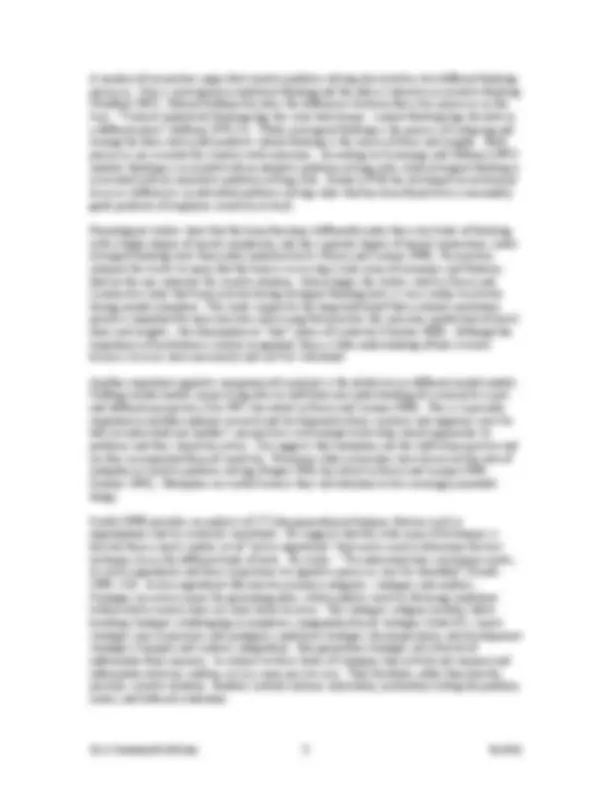
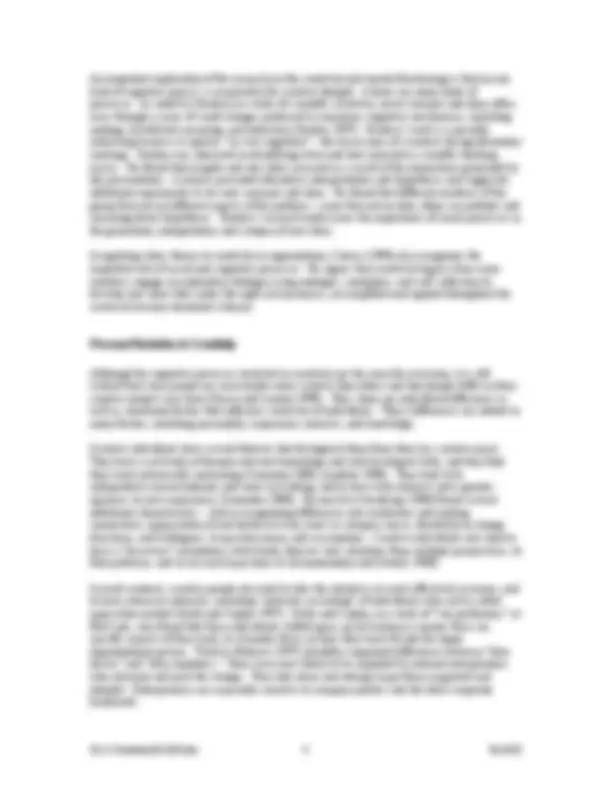
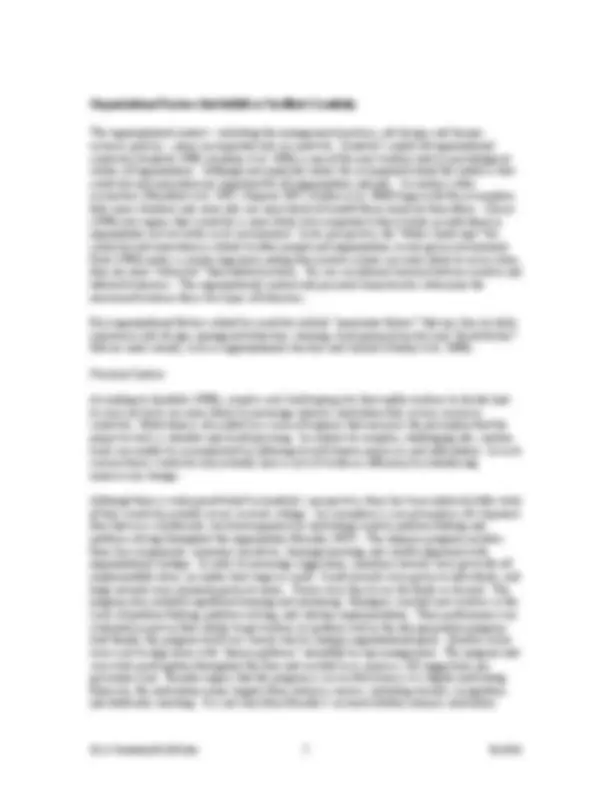
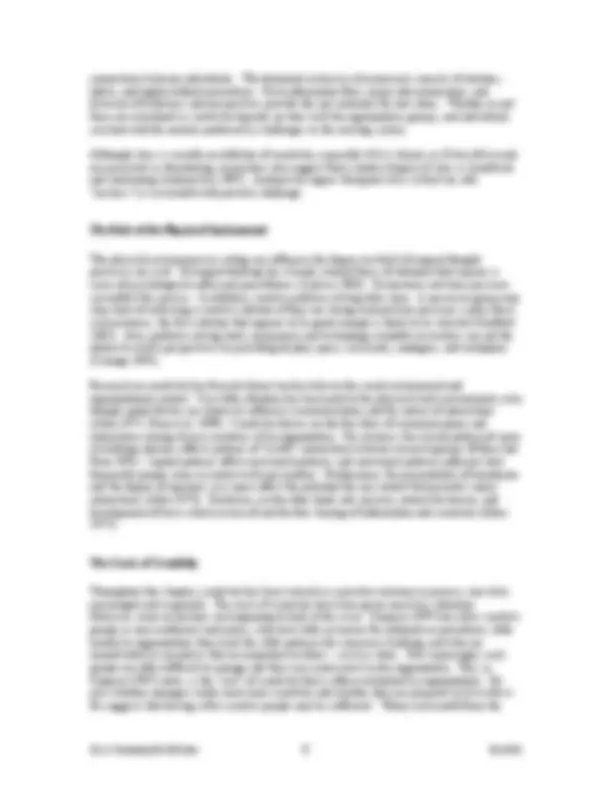
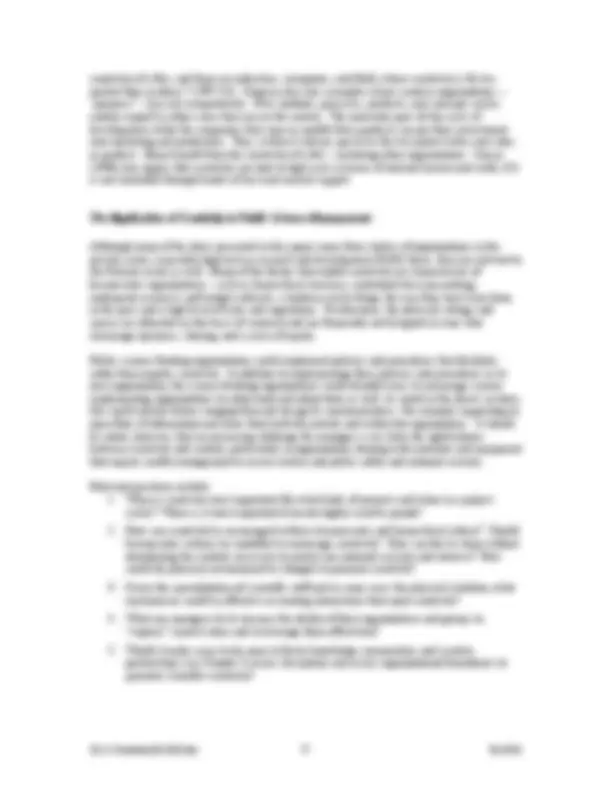
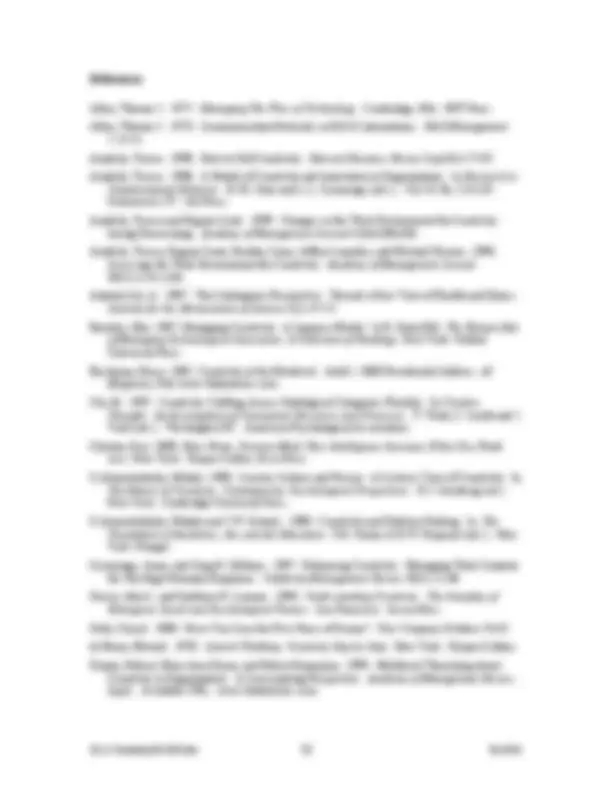


Study with the several resources on Docsity

Earn points by helping other students or get them with a premium plan


Prepare for your exams
Study with the several resources on Docsity

Earn points to download
Earn points by helping other students or get them with a premium plan
Community
Ask the community for help and clear up your study doubts
Discover the best universities in your country according to Docsity users
Free resources
Download our free guides on studying techniques, anxiety management strategies, and thesis advice from Docsity tutors
Management Benchmark Study-Book Summary Chapter 15-Literature-Elizabeth L. Malone Creativity, Judith H. Heerwagen, Mental Models, Organizational Factors that Inhibit or Facilitate Creativity, Role of the Physical Environment
Typology: Summaries
1 / 12

This page cannot be seen from the preview
Don't miss anything!







Research on organizational creativity has increased rapidly in the last decade. Not only is creativity of interest to scientific researchers, it has become a compelling topic in the popular media, with recent articles in Psychology Today (Gryskiewicz 2000), Fast Company (Dahl 2000), and in business-oriented publications such as the Harvard Business Review (Hargadon and Sutton 2000). Why this intense interest, and why now? Part of the answer comes from the nature of science and business today, especially in competitive fields where the pressure for innovation and maintaining a competitive edge has become more intense. Creativity provides the raw intellectual materials – ideas, concepts, insights, and discovery – that eventually become new theories, approaches, tools, products, and services that underlie innovation. Innovation is the adoption and social transmission of creative discovery.
Although creativity and innovation are closely intertwined in the public eye, they have often been studied in isolation by researchers using different methodologies and models. Creativity has been the province of psychology, with its emphasis on individuals and small groups, while innovation has been the focus of sociologists, economists, and others who take a larger, systems perspective. This separation is unfortunate, because creativity (producing something for the first time) represents “a dramatic aspect of organizational change that may provide a key to understanding change phenomena and, ultimately, organizational effectiveness and survival” (Woodman et al. 1993). Recent attempts to integrate the psychological and sociological perspectives include work by Ford (1996, 2000), Cummings and Oldham (1997), and Drazin, Glynn and Kazanjian (1999).
Creativity is generally defined as useful novelty – not novelty for its own sake, but novelty that can be applied and add value to an organization’s products and services (Oldham and Cummings 1996). Creativity includes the generation of ideas, alternatives, and possibilities (Smith 1998). Creativity research has a long history in psychology, focusing on individual differences in personality, cognitive abilities, and problem-solving styles. However, recent theoretical and empirical work looks at creativity as something the brain does naturally. That is, creativity is an adaptive feature of normal cognitive functioning that evolved to aid problem solving under conditions of uncertainty. Under such circumstances, novel approaches and invention are highly advantageous (Simonton 2000; Findlay and Lumsden 1988). This perspective asserts that all human beings have the potential for creativity because we share common neural processes; however, whether the creativity is expressed or suppressed depends on the socio-cultural context, personality differences, and specific personal experiences (such as knowledge and skills). Within work settings, it is also apparent that organizational policies and practices as well as managerial behaviors influence creativity among workers.
By defining creativity as useful novelty, psychologists have clearly placed the emphasis on creativity as an outcome. Others, however, are beginning to look at creativity as a process that
(^1) Related chapters include: Change Management, Knowledge Management; Competencies; Organizational
Culture; Innovation.
ebbs and flows over time in response to problems that arise unpredictably (Drazin et al. 1999). In this view, creativity is intricately connected to sense-making, problem finding, and interpretation of events and situations. Although traditional approaches recognize the importance of social processes in creativity, they view social interactions as important for the generation and discussion of ideas, not for sense-making and interpretation. However, as Drazin and colleagues argue, organizational problems that require creativity are often complex, fluid, ambiguous, and occur over long time periods and thus require significant sense-making activity. In contrast, creativity research has tended to focus on bounded problems solved by small groups.
Traditional perspectives also look at creativity as something that can be manipulated once the factors that promote or inhibit creativity are known. These models presume that creativity at lower levels (individual, group) aggregate to produce organizational level creativity. In contrast, Drazin et al. (1999) argue that creativity at the organizational level emerges from the process of negotiating multiple meanings and potentially competing interests between different groups within an organization. In order to understand one another, people engage in the development of joint meanings, which, in turn, motivate engagement and this generates creativity. Creativity is associated with crisis resolution that leads to renewed sense-making and a shift in belief structures.
Regardless of whether creativity is considered a process or an outcome, it is ultimately linked to social processes and contexts and can be considered from a systems perspective (Csikszentmihalyi 1988). The systems perspective views the individual as the source of variation and change (new ideas) that are presented to others who then select and retain creative ideas that are used to elaborate the larger domain. The results of the elaboration are fed back to the individual and the process continues. A key question for organizational leaders is: What sparks the variation in the first place? How do creative ideas happen? What inhibits or suppresses creative ideation?
To understand creativity in the workplace, it is useful to review briefly the cognitive, social, motivational, and emotional processes that influence creative problem solving. After a brief review of these factors, the situational and organizational influences on creativity are discussed.
The cognitive processes that generate creative outcomes do not differ from everyday thinking (Buchanan 2001). What differs is the context in which the creative ideas arise: The context both motivates and determines the value and usefulness of the ideas. Two key cognitive processes are involved in creative problem solving: ♦ Combinatorial – producing novel combinations out of familiar ideas/things through generating and testing. ♦ Transformational – using analogical reasoning and metaphors to transfer concepts from one domain to another.
Creativity also relies heavily on a sound knowledge base. As noted by Buchanan (2000), background knowledge is an essential element that distinguishes deliberate acts of creation from “accidental creativity.” Background knowledge not only aids idea generation, it also supports the valuation component of creativity; it places the idea in a context and suggests why it is important (Kuhn 1970).
An important implication of the research on the creativity and mental functioning is that no one kind of cognitive process is responsible for creative thought: it draws on many kinds of processes. As noted by Dunbar in a study of scientific creativity, novel concepts and ideas often arise through a series of small changes produced by numerous cognitive mechanisms, including analogy, distributed reasoning, and deduction (Dunbar 1997). Dunbar’s work is especially interesting because it captures “in vivo cognition” – the discussions of scientists during laboratory meetings. Dunbar was interested in identifying when and how innovative scientific thinking occurs. He found that insights and new ideas occurred as a result of the interactions generated by lab presentations. Listeners presented alternative interpretations and hypotheses and suggested additional experiments to test new concepts and ideas. He found that different members of the group focused on different aspects of the problem – some focused on data, others on methods and reasoning about hypotheses. Dunbar’s research underscores the importance of social processes in the generation, manipulation, and critique of new ideas.
In applying chaos theory to creativity in organizations, Stacey (1996) also recognizes the important role of social and cognitive processes. He argues that creativity begins when some members engage in exploratory dialogue using analogies, metaphors, and self- reflection to develop new ideas that, under the right circumstances, are amplified and applied throughout the system to become dominant schemas.
Although the cognitive processes involved in creativity are the same for everyone, it is still evident that some people are consistently more creative than others and that people differ in their creative outputs over time (Dacey and Lennon 1998). Thus, there are individual differences as well as situational factors that influence creativity of individuals. These differences are related to many factors, including personality, experience, interests, and knowledge.
Creative individuals have several features that distinguish them from their less creative peers: They have a rich body of domain-relevant knowledge and well-developed skills, and they find their work intrinsically motivating (Simonton 2000; Amabile 1988). They tend to be independent, unconventional, and more risk-taking, and to have wide interests and a greater openness to new experiences (Simonton 2000). Research by Sternberg (1988) found several additional characteristics: skill in recognizing differences and similarities and making connections; appreciation of and ability to write, draw or compose music; flexibility to change directions; and willingness to question norms and assumptions. Creative individuals also tend to have a “discovery” orientation, which leads them to view situations from multiple perspectives, to find problems, and to ask novel questions (Csikszentmihalyi and Getzels 1988).
In work contexts, creative people also tend to take the initiative, to work effectively in teams, and to have extensive networks, including “networks in waiting” of individuals who can be called upon when needed (Kelly and Caplan 1997). Kelly and Caplan, in a study of “star performers” at Bell Labs, also found that these individuals shifted gears easily between a narrow focus on specific aspects of their work, to a broader focus on how their work fit into the larger organizational picture. Work by Roberts (1997) identifies important differences between “idea- havers” and “idea-exploiters.” Ideas were most likely to be exploited by internal entrepreneurs who advocate and push for change. They take ideas and attempt to get them supported and adopted. Entrepreneurs are especially sensitive to company politics and the latest corporate buzzwords.
The organizational context – including the management practices, job design, and human resource policies – plays an important role in creativity. Amabile’s model of organizational creativity (Amabile 1988; Amabile et al. 1996) is one of the most widely cited in psychological studies of organizations. Although not explicitly stated, the assumption behind the model is that creativity and innovation are important for all organizations and jobs. In contrast, other researchers (Mumford et al. 1997; Shapero 1997; Shalley et al. 2000) begin with the assumption that some situations and some jobs are more likely to benefit from creativity than others. Stacey (1996) also argues that creativity is more likely to be important when it helps an individual or organization survive better in its environment. In his perspective, the “fitness landscape” for creativity and innovation is related to other people and organizations in any given environment. Ford (1996) makes a similar argument, noting that creative actions are more likely to occur when they are more “attractive” than habitual actions. He sees an inherent tension between creative and habitual behaviors. The organizational context and personal characteristics determine the movement between these two types of behaviors.
Key organizational factors related to creativity include “proximate factors” that are close to daily experience (job design, managerial behaviors, training, work group diversity) and “distal factors” that are more remote, such as organizational structure and climate (Shalley et al. 2000).
According to Amabile (1988), complex and challenging jobs that enable workers to decide how to carry out tasks are more likely to encourage intrinsic motivation that, in turn, increases creativity. Motivation is also aided by a sense of urgency that increases the perception that the project or task is valuable and worth pursuing. In contrast to complex, challenging jobs, routine work can readily be accomplished by adhering to well-known processes and information. In such circumstances creativity may actually incur a cost if it reduces efficiency by introducing unnecessary change.
Although there is widespread belief in Amabile’s perspective, there has been relatively little study of how creativity actually occurs in work settings. An exception is a recent analysis of a Japanese firm that uses a deliberate, structural approach to motivating creative problem finding and problem solving throughout the organization (Basadur 1997). The Japanese program includes three key components: monetary incentives, training/coaching, and careful alignment with organizational strategy. In order to encourage suggestions, monetary rewards were given for all implementable ideas, no matter how large or small. Small rewards were given to individuals, and large rewards were primarily given to teams. Teams were free to use the funds as desired. The program also included significant training and mentoring. Managers coached new workers in the cycle of problem finding, problem solving, and solution implementation. Their performance was evaluated in part on their ability to get workers to perform well in the idea generation program. And finally, the program itself was closely tied to strategic organizational goals. Quality circles were used to align ideas with “theme problems” identified by top management. The program had very wide participation throughout the firm and resulted in as many as 140 suggestions per person/per year. Basadur argues that the program is successful because it is highly motivating. However, the motivation comes largely from extrinsic sources, including rewards, recognition, and deliberate coaching. It is not clear from Basadur’s account whether intrinsic motivation
toned moods than when they are in neutral or negative moods (Isen 1990; Isen and Baron 1991; Isen et al. 1987). The studies show that positive moods also have numerous beneficial impacts on cognitive and social functioning, including more efficient decisional processes on complex tasks and more innovative approaches to negotiations. Creative problem solving is less likely when people are depressed, unhappy, or stressed. This is because negative moods or stress tend to restrict attention and lead to stereotypic responses (Gazzaniga 1988). The relationship between emotional functioning and creativity raises questions about how work relationships, events, and other factors in the work environment influence positive and negative mood states and what the consequences are for creative efforts (Ford 1996). At the present time, little is known. Isen’s own research has used traditional experimental paradigms in which mood is manipulated, often through the presentation of a small gift (such as candy).
Distal factors, which set the overall context in which creative behaviors occur, include resources, organizational adaptability, organizational culture, and levels of internal strife..
Resources are important not only for functional support, but also because having an adequate level of resources for the task/project influences workers’ perceptions that the project is valuable and worthy of organizational support. Resources include financial support as well as time, physical space, and information (Mumford et al. 1997).
Another distal factor influencing creativity is organizational adaptability. Highly adaptive organizations tend to be more supportive of creativity (Basadur 1997). Adaptability means continually and intentionally changing routines to find better ways of doing business. Adaptable organizations engage in “opportunistic surveillance” – which means scanning the environment to anticipate new opportunities and problems and responding with new methods and approaches. Organizations that show low adaptability exhibit high levels of control through centralized decision making. Rigid adherence to rules and regulation tends to have negative impacts on creativity. This may occur through numerous mechanisms. For instance, Amabile ((1998) argues that centralized decision making and adherence to rules and regulations reduces intrinsic motivation, with corresponding decreases in creativity and the ability to cope with problems and demands, both of which detract from well-being. Centralized decision-making and control also reduces information flow through an organization. To the extent that creativity requires free access to information and knowledge, this will dampen the generation of new ideas.
The degree and nature of internal strife in an organizational also influences creativity. Strife and conflict increase stress that, in turn, generates use of familiar strategies and behaviors rather than novel approaches (Gazzaniga 1988). Stress also generates negative moods and anxiety, which, as noted above, inhibit creative functioning.
Stacey (1996) also looks at conflict as a potential inhibitor of creativity. Ironically, however, conflict is also a generator of creativity. Drawing on chaos theory, Stacey argues that creativity arises from the conflict between an organization’s existing system and an emerging “shadow” system. The existing “legitimate” system in an organization tends to be conforming and hierarchical. Creativity originates in the organization’s shadow system that is characterized by diversity, ambiguity, contention, and speculations brought about by new ideas that threaten the current norms and values. Stacey argues that an organization at the edge of chaos doesn’t display chaos itself. Instead it shows stability and then sudden change to a new form that has been slowly evolving in the shadow system. Bureaucratic organizations with high levels of centralization are difficult to move in a creative direction because they have restricted information flow and few
connections between individuals. The dominant system in a bureaucracy consists of routines, habits, and highly defined procedures. Rich information flow, many interconnections, and diversity of behaviors and perspectives provide the raw materials for new ideas. Whether or not these are actualized as creativity depends on how well the organization, groups, and individuals can deal with the anxiety produced by challenges to the existing system.
Although stress is usually an inhibitor of creativity, especially if it is chronic or if stressful events are perceived as threatening, researchers also suggest that a modest degree of stress is beneficial and motivating (Antonovsky 1987). Antonovsky argues that good stress (which he calls “eustress”) is associated with positive challenge.
The physical environment or setting can influence the degree to which divergent thought processes are used. Divergent thinking has a broad, relaxed focus of attention that requires a sense of psychological safety and peacefulness (Isaksen 1983). Distractions and time pressures can inhibit this process. In addition, creative problem solving takes time. A person or group may stop short of achieving a creative solution if there are strong external time pressures; under these circumstances, the first solution that appears to be good enough is likely to be selected (Guilford 1967). Also, problem solving tools, equipment, and technology available to workers can aid the ability to switch perspectives by providing display space, visual aids, analogies, and metaphors (Schrage 1995).
Research on creativity has focused almost exclusively on the social environment and organizational context. Very little attention has been paid to the physical work environment, even though spatial factors are known to influence communications and the nature of interactions (Allen 1977; Penn et al. 1999). Creativity thrives on the free flow of communications and interactions among diverse members of an organization. For instance, the overall pattern of space in building interiors affects patterns of “useful” interactions between research groups (Hillier and Penn 1991). Spatial patterns affect movement patterns, and movement patterns influence how frequently people come in contact with one another. Furthermore, the permeability of boundaries and the degree of openness in a space affect the potential for eye contact that precedes many interactions (Allen 1973). Enclosure, on the other hand, aids privacy, mutual disclosure, and development of trust, which in turn all aid the free sharing of information and creativity (Allen 1977).
Throughout this chapter, creativity has been viewed as a positive outcome or process, one to be encouraged and supported. The costs of creativity have been given much less attention. However, some researchers are beginning to look at this issue. Shapero (1997) describes creative people as non-conformist and jokers, who have little reverence for authority or procedures, little loyalty to organizations they work for, little patience for consensus building, and who are unmotivated by incentives that are important to others – such as status. Not surprisingly, such people are often difficult to manage and they can create unrest in the organization. This, as Shapero (1997) notes, is the “cost” of creativity that is often overlooked by organizations. He asks whether managers really need more creativity and whether they are prepared to live with it. He suggests that having a few creative people may be sufficient: “Many can benefit from the
Allen, Thomas J. 1977. Managing The Flow of Technology. Cambridge, MA: MIT Press.
Allen, Thomas J. 1973. Communication Networks in R& D Laboratories_. R&D Management_ 1:14-21.
Amabile, Teresa. 1998. How to Kill Creativity. Harvard Business Review Sept-Oct:77-87.
Amabile, Teresa. 1988. A Model of Creativity and Innovation in Organizations. In Research in Organizational Behavior. B. M. Staw and L.L. Cummings (eds.). Vol 10: Pp. 123-167. Greenwich, CT: JAI Press.
Amabile, Teresa and Regina Conti. 1999. Changes in the Work Environment for Creativity during Downsizing. Academy of Management Journal 42(6):630-640.
Amabile, Teresa, Regina Conti, Heather Coon, Jeffrey Lazenby, and Michael Herron. 1996. Assessing the Work Environment for Creativity. Academy of Management Journal 39(5):1154-1184.
Antonovsky, A. 1987. The Salutogenic Perspective: Toward a New View of Health and Illness. Institute for the Advancement of Science 4(1):47-55.
Basadur, Min. 1997. Managing Creativity: A Japanese Model. In R. Katz (Ed). The Human Side of Managing Technological Innovation: A Collection of Readings. New York: Oxford University Press.
Buchanan, Bruce. 2001. Creativity at the Metalevel. AAAI –2000 Presidential Address. AI Magazine , Fall. www.findarticles.com
Chi, M. 1997. Creativity: Shifting Across Ontological Categories Flexibly. In Creative Thought: An Investigation of Conceptual Structures and Processes. T. Ward, S. Smith and J. Vaid (eds.). Washington DC: American Psychological Association.
Claxton, Guy. 2000. Hare Brain, Tortoise Mind. How Intelligence Increases When You Think Less. New York: Harper Collins, Ecco Press.
Csikszentmihalyi, Mihaly. 1988. Society, Culture and Person: A Systems View of Creativity. In The Nature of Creativity: Contemporary Psychological Perspectives. R.J. Sternberg (ed.). New York: Cambridge University Press.
Csikszentmihalyi, Mihaly and J.W. Getzels. 1988. Creativity and Problem Finding. In The Foundation of Aesthetics, Art, and Art Education. F.H. Farley & R.W. Neperud (eds.). New York: Praeger.
Cummings, Anne, and Greg R. Oldham. 1997. Enhancing Creativity: Managing Work Contexts for The High Potential Employee. California Management Review 40(1):22-38.
Dacey, John S. and Kathleen H. Lennon. 1998. Understanding Creativity: The Interplay of Biological, Social and Psychological Factors. San Francisco: Jossey-Bass.
Dahl, Cheryl. 2000. Have You Seen the Five Faces of Genius? Fast Company October:54-62.
de Bono, Edward. 1970. Lateral Thinking: Creativity Step by Step. New York: Harper-Collins.
Drazin, Robert, Mary Ann Glynn, and Robert Kazanjian, 1999. Multilevel Theorizing about Creativity in Organizations: A Sensemaking Perspective. Academy of Management Review , April. Available URL: www.findarticles.com.
Dunbar, Kevin. 1997. How Scientists Think: On Line Creativity and Conceptual Change in Science. In Creative Thought: An Investigation of Conceptual Processes and Structures. T.S. Ward, S.M. Smith and J. Vaid (eds). Washington D.C: American Psychological Association.
Findlay, C. Scott, and Charles J. Lumsden. 1988. The Creative Mind: Toward an Evolutionary Theory of Discovery and Innovation. Journal of Social and Biological Structure 11:3-55.
Ford, Cameron. 1996. A Theory of Individual Creative Action in Multiple Social Domains. Academy of Management Review. 21(4):1112-1142.
Gardner, Howard. 1982. Art, Mind and Brain: A Cognitive Approach to Creativity. New York: Basic Books.
Gazzaniga, M. 1988. Mind Matters. Boston: Houghton Mifflin.
Gryskiewicz, Stanley S. 2000. Cashing in on Creativity at Work. Psychology Today September/October:63-65.
Guilford, J.P. 1967. The Nature of Human Intelligence. New York: McGraw-Hill.
Hargadon, Andrew B. 1999. Group Cognition and Creativity in Organizations. Research on Managing Groups and Teams. Vol 2. Pp. 137-155. Greenwich, CT: JAI Press Inc.
Hargadon, Andrew, and Robert Sutton. 2000. Building an Innovation Factory. Harvard Business Review May-June:157-166.
Hillier, Bill, and Jullienne Hanson. 1984_. The Social Logic of Space_. Cambridge, UK: Cambridge University Press.
Hillier, Bill, and A. Penn. 1991. Visible Colleges: Structure and Randomness in the Place of Discovery. Science in Context 4(1):23-49.
Isaksen, Scott. 1983. Toward a Model for the Facilitation of Creative Problem Solving. Journal of Creative Behavior 17(1):18-31.
Isen, Alice M. 1990. The Influence of Positive and Negative Affect on Cognitive Organization: Some Implications for Development. In Psychological and Biological Approaches to Emotion. N.L .Stein, B. Leventhal, T. Trabasso (eds.). Hillsdale, NJ: Erlbaum.
Isen, Alice M., and Robert Baron. 1991. Positive Affect as a Factor in Organizational Behavior. In Research in Organizational Behavior. L.L. Cummings and B.M. Staw (eds.). Greenwich, CT: JAI Press.
Isen, Alice.M.,,Kimberley A. Daubman, and Gary P Nowicki. 1987. Positive Affect Facilitates Creative Problem Solving. Journal of Personality and Social Psychology 52(6):1122-1131.
Kelly, Robert and Janet Caplan. 1997. How Bell Labs Creates Star Performers. In The Human Side of Managing Technological Innovation: A Collection of Readings. R. Katz (ed.). New York: Oxford University Press.
Kirton, M.J. 1976. Adaptors and Innovators: A Description and Measure. Journal of Applied Psychology 61(5):622-629.
Kogan, N. 1983. Stylistic Variation in Childhood and Adolescence: Creativity, Metaphor, Cognitive Styles. In Handbook of Child Psychiatry. P.H. Mussen (ed). Volume 3. New York: Wiley.
Kuhn, Thomas. 1970. The Structure of Scientific Revolutions. Chicago: University of Chicago Press.